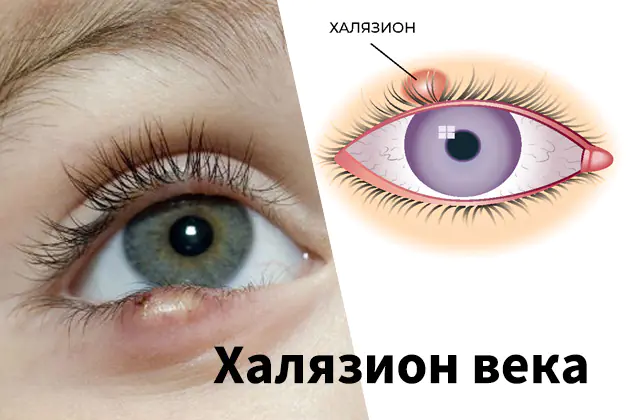
Description and causes of chalazion of the eyelid. Main symptoms and diagnosis. Methods of treatment, prevention.
The content of the article:- What is a chalazion of the eyelid
- Reasons for development
- Main symptoms
- Treatment options
- Medicines
- Surgical intervention
- Laser therapy
- Folk remedies
- Prevention measures
A chalazion is a benign tumor-like compaction in the shape of a hailstone that affects the thickness of the eyelid. It is a nodular formation or swelling that puts pressure on the eyeballs and irritates the membranes of the eyes. It occurs due to blockage and inflammatory reactions in the area of the meibomian glands, localized in the thickness of the eyelid. In severe cases of the pathological process, an inflammatory reaction, suppuration, and spontaneous opening of the hailstone are observed.
What is a chalazion of the eyelid?
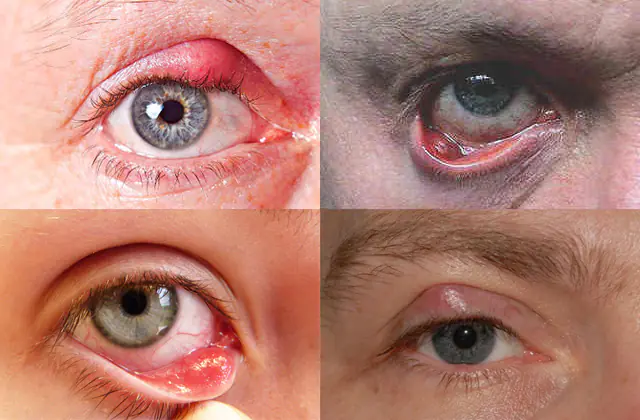
The photo shows a chalazion of the upper and lower eyelids
Chalazion of the eyelid is a chronic inflammatory process of the eyelid that occurs when the meibomian glands are blocked. This is a common ophthalmological disease, which is detected in more than 7% of patients who consult a doctor with visual dysfunction.
Meibomian glands are localized in the thickness of cartilaginous tissue, have a tubular structure, and their outlet ducts face the inner surface of the eyelids. Their main function is to keep the eyeballs moisturized and prevent the evaporation of tears. Each eyelid contains 65-75 such glands, responsible for the production of the lipid layer of tear films.
Patients with diabetes, barley, colds, as well as people who use contact lenses and do not follow personal hygiene rules are at risk of developing eyelid chalazion. Most often, chalazion is diagnosed in people in the age range of 35-55 years.
There is a possibility of chronic inflammatory process. The main complications of chalazion include suppuration of the eyelids, severe pain and pulsation, swelling, and inflammatory processes. When the optic nerves are compressed, hemorrhage occurs in the retinal area and atrophy of the nerve endings. In severe cases, permanent visual impairment is observed.
Reasons for the development of chalazion of the eyelid
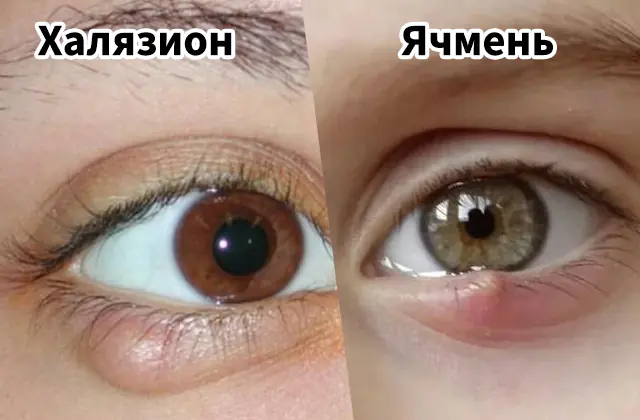
The photo shows the difference between a chalazion and a stye - a stye is localized on the outer edge of the eyelid, a chalazion is located in the thickness of the eyelid, this is the main difference. Barley is an acute purulent infection of the eyelid, and chalazion is a chronic formation of a non-infectious nature. With barley, the pain is more pronounced, while chalazion has fewer manifestations.
Chalazion of the upper eyelid can develop in patients who have previously had a stye. If it is poorly treated or relapses, the sebaceous glands become clogged and a secondary inflammatory process develops.
Predisposing factors for the development of chalazion include:
- enterocolitis;
- increased activity of the sebaceous glands;
- gastritis;
- dysbacteriosis;
- chronic blepharitis;
- seborrhea;
- biliary dyskinesia;
- diabetes;
- enterocolitis;
- rosacea;
- prolonged stress;
- hypothermia;
- deficiency of vitamins and microelements;
- failure to comply with personal hygiene rules.
Associated factors that lead to disruption of the functioning of the immune system: stress, hypothermia, previous bacterial or viral infection, hypovitaminosis, infection in the organs of vision.
The causes of chalazion of the eyelid are associated with blockage of the meibomian glands, as a result of which the outflow of lipid secretion, which accumulates inside the ducts, is disrupted. The glandular tissues begin to become inflamed, encapsulation of the pathological focus occurs, and the formation of benign seals in the form of small nodules.
Main symptoms of eyelid chalazion
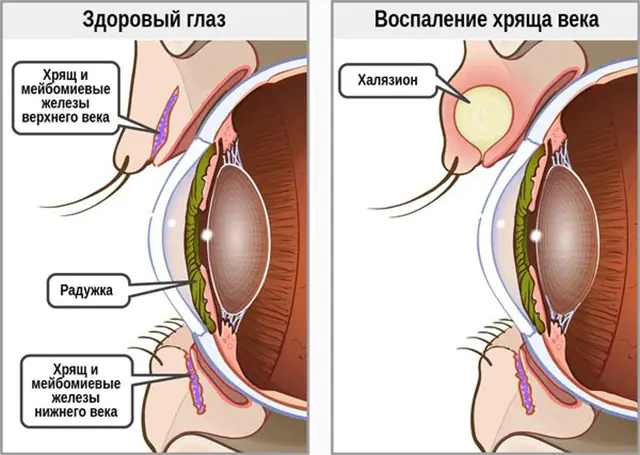
The initial stage of a chalazion of the lower eyelid is similar to a stye: the affected eye swells, complaints of pain and irritation occur. In some cases, the disease is asymptomatic, and the formation may gradually increase in size. The more the chalazion enlarges, the more swelling is visible on the skin. Over time, cosmetic imperfections cause psychological discomfort and worsen the quality of life.
The progression of the chalazion of the eyelid leads to itching, increased lacrimation, and increased sensitivity to palpation. When pressure is applied to the cornea, astigmatism develops and visual acuity deteriorates.
Important! If the chalazion does not open and persists for a long time, there is a danger of its transformation into a cystic formation with mucous contents.Suppuration is accompanied by accompanying symptoms such as:
- swelling;
- local redness of the skin;
- throbbing pain;
- softening of the nodule.
With chalazion of the eyelid, symptoms may resolve on their own or intensify over time. Lack of medical care leads to increased body temperature and the development of blepharitis. If the chalazion opens on its own, a purulent secretion forms on the surface of the conjunctiva. This leads to the formation of a fistula, dryness and redness of the skin, and the formation of crusts.
The decision on how to treat eyelid chalazion is made by the doctor after an examination. To make an accurate diagnosis, an ophthalmologist examines the patient. When the eyelids are everted, swelling is visible and the conjunctiva is inflamed. The affected eye blinks less often. In most cases, specific diagnostics are not necessary to confirm a chalazion. If there is a suspicion of the development of adenocarcinoma of the meibomian glands, histological studies are performed.
Methods for treating eyelid chalazion
Conservative treatment of eyelid chalazion is recommended in the early stages of the disease. The use of thermal procedures during the acute course of the pathological process is strictly contraindicated. Preference is given to UHF therapy, eyelid massage for chalazion and clogged glands.
Medications for eyelid chalazion
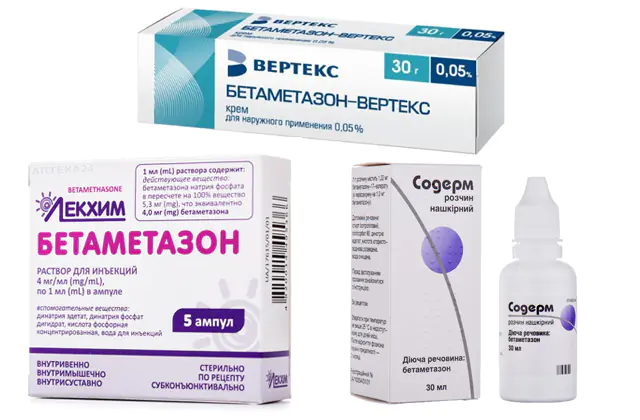
Injection of corticosteroids into the chalazion area has a pronounced therapeutic effect. Patients are prescribed Betamethasone, which quickly stops the inflammatory process, reduces the symptoms of the disease, and leads to the resorption of tumors. The medicine should only be administered by an experienced healthcare professional using a thin needle. Cost - from 140 rubles. (55 UAH). Analogue - Soderm.
Surgical intervention for chalazion of the eyelid

If conservative measures are ineffective, the patient is recommended to undergo eyelid chalazion surgery. The procedure is performed in an outpatient clinic using local anesthesia. The selection of a suitable surgical therapy technique is carried out taking into account certain factors:
- what is the patient’s blood clotting ability;
- how a person tolerates anesthetic drugs;
- Do you have a history of chronic pathologies?
The surgeon makes a small skin incision and removes the tumor, which is located in the capsule. If a fistula has formed, an incision is made along its entire length, and the affected tissue is excised. After the procedure is completed, stitches are placed on the operated eyelids. A tight pressure bandage is also used.
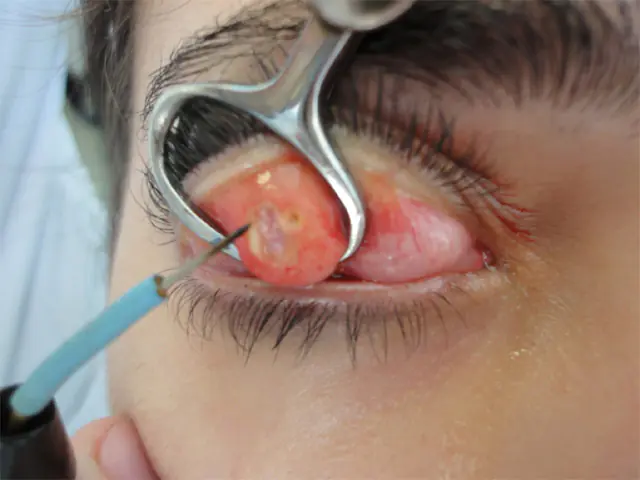
During the recovery period after a chalazion of the eyelid, the patient is under constant medical supervision to prevent complications. Swelling and hematomas persist for 7-14 days. After a few days, the stitches will be removed and the patient will be able to return to their normal lifestyle.
Surgical intervention is contraindicated in case of inflammatory processes in the area of the visual organs, exacerbation of an infectious or cardiovascular disease.
Laser therapy for eyelid chalazion
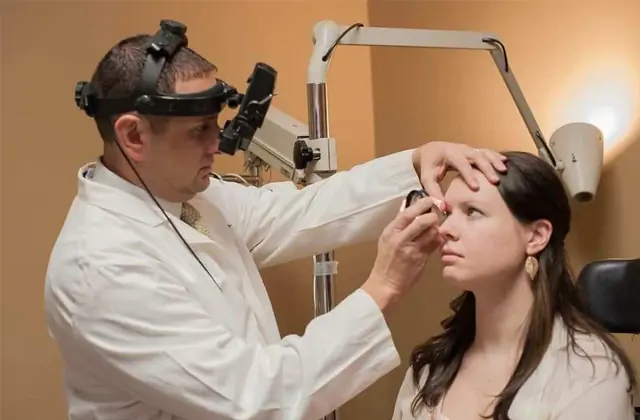
Laser treatment of chalazion is an alternative to surgical therapy. Using a laser, the capsule is cut, its contents are removed and the shell is dissolved.
Laser therapy for eyelid chalazion is a modern, safe and painless technique. It is not accompanied by blood loss and is well tolerated. The procedure is characterized by minimal trauma and a quick recovery period; there is no risk of secondary bacterial infection. After it is performed, there is no need for stitches or pressure bandages. The likelihood of re-development of the pathological process is minimal.
To prevent negative effects on the cornea, the patient is prescribed the use of a soft contact lens during the recovery period after the procedure. In addition, make sure that no water gets into the treated eye. A week later, you need to see your doctor for a follow-up examination.
Folk remedies against chalazion of the eyelid
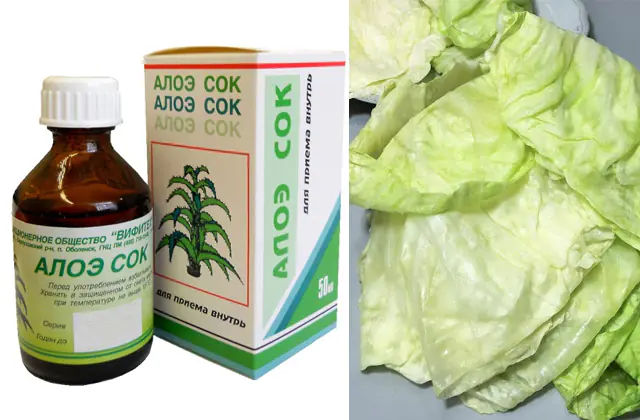
Traditional treatment of eyelid chalazion is an auxiliary type of therapy, which is used with prior agreement with a doctor.
Traditional medicine suggests the use of the following recipes:
- Aloe juice is used in the treatment of eye diseases. The leaves of the plant are cut, washed, cut and the juice is squeezed out. The resulting product is applied to the affected eyelids 3-5 times a day. The resulting juice can be stored in the refrigerator in a glass container with a tight-fitting lid. The juice is rubbed in with gentle massage movements to ensure fluid outflow. The plant reduces the inflammatory reaction, swelling, redness, itching in the eyes, and the likelihood of a bacterial or viral infection. Aloe is well tolerated and suitable for patients of all age groups. Long-term therapy over several months under the supervision of an ophthalmologist is acceptable. Aloe can be replaced with Kalanchoe.
- To reduce the symptoms of eyelid chalazion, compresses based on cabbage leaves are used. The plant is washed and mixed with egg white. The resulting product is generously moistened with a piece of bandage or gauze and applied to the affected area. This compress prevents the formation of compactions and ensures easy outflow of fluid. To enhance the therapeutic effect after the compress, you can rinse your eyes with strong tea leaves.
- During non-exacerbation periods, the eyelids are heated with rock or sea salt. It is heated in a frying pan and poured into a linen bag. Use for warming up once a day, in the evening. The bag of salt is often replaced with a warm chicken egg.
- Patients with chalazion of the eyelid are recommended to take figs boiled in milk internally. This product is rich in fiber, valuable vitamins and microelements, exhibits antibacterial and regenerating properties, and normalizes the functioning of the immune system. The drug is taken once a day for 7 days, after which a break is taken. The course of treatment can be repeated under medical supervision.
- Warm herbal compresses are used to normalize blood circulation and ensure natural drainage. To prepare a healing solution, mix parsley, calendula, chamomile and raspberries in equal parts. The herbal mixture is poured with hot water and left for 15 minutes. The resulting product is cooled and filtered. Cotton pads are generously moistened and applied to the eyelids for 5-10 minutes. The procedure can be performed 1-2 times a day for 30 days.
If, during therapy, the patient notices that the chalazion of the eyelid is increasing in size and symptoms appear in the form of pain, itching, discomfort, increased lacrimation, stop using folk remedies and consult a doctor.
Measures to prevent chalazion of the eyelid

As part of the prevention of eyelid chalazion, it is recommended to focus efforts on strengthening the immune system: minimizing the consumption of foods that create additional stress and potentially provoke inflammation (dairy and refined products, gluten, sugar). You should also promptly identify and compensate for deficiencies of important vitamins (vitamin D), prohormones and minerals (zinc, selenium, iron).
In addition, it is necessary to sanitize the foci of inflammation. To do this, check the dental canals, tonsils, and maxillary sinuses.
To prevent eyelid chalazion, it is also recommended:
- observe the rules of personal hygiene,
- lead a healthy lifestyle - eliminate bad habits, give preference to moderate physical activity;
- promptly treat blepharitis, meibomitis and other diseases of the organs of vision;
- review your diet, introduce seasonal fruits and vegetables, herbs, fermented foods, dark-skinned berries;
- observe a work and rest schedule - go to bed on time no later than 23:00, use relaxing techniques for the eyes and body.
At the first signs of a chalazion of the eyelid, it is recommended to refrain from self-medication and seek advice from an experienced ophthalmologist. Self-medication can aggravate the clinical picture and provoke serious complications. With a chalazion of the eyelid, the eyes begin to see worse, and the sooner treatment begins, the more favorable the prognosis for the patient.
Video about chalazion of the upper and lower eyelids - photos, treatment, reasons:



